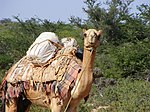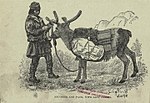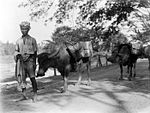
A camel is an even-toed ungulate in the genus Camelus that bears distinctive fatty deposits known as "humps" on its back. Camels have long been domesticated and, as livestock, they provide food and textiles. Camels are working animals especially suited to their desert habitat and are a vital means of transport for passengers and cargo. There are three surviving species of camel. The one-humped dromedary makes up 94% of the world's camel population, and the two-humped Bactrian camel makes up 6%. The wild Bactrian camel is a distinct species that is not ancestral to the domestic Bactrian camel, and is now critically endangered, with fewer than 1,000 individuals.

A cart or dray is a vehicle designed for transport, using two wheels and normally pulled by draught animals such as horses, donkeys, mules and oxen, or even smaller animals such as goats or large dogs.
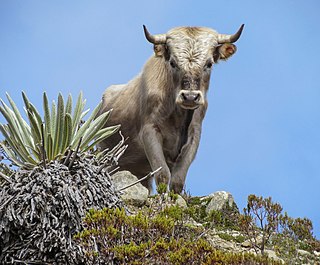
A feral animal or plant is one that lives in the wild but is descended from domesticated individuals. As with an introduced species, the introduction of feral animals or plants to non-native regions may disrupt ecosystems and has, in some cases, contributed to extinction of indigenous species. The removal of feral species is a major focus of island restoration.

Camelids are members of the biological family Camelidae, the only currently living family in the suborder Tylopoda. The seven extant members of this group are: dromedary camels, Bactrian camels, wild Bactrian camels, llamas, alpacas, vicuñas, and guanacos. Camelids are even-toed ungulates classified in the order Artiodactyla, along with species including whales, pigs, deer, cattle, and antelopes.

The dromedary, also known as the dromedary camel, Arabian camel, or one-humped camel, is a large camel, of the genus Camelus, with one hump on its back.
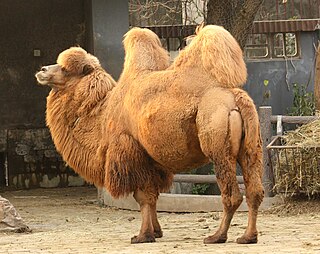
The Bactrian camel, also known as the Mongolian camel, domestic Bactrian camel or two-humped camel, is a large camel native to the steppes of Central Asia. It has two humps on its back, in contrast to the single-humped dromedary. Its population of 2 million exists mainly in the domesticated form. Their name comes from the ancient historical region of Bactria.
The United States Camel Corps was a mid-19th-century experiment by the United States Army in using camels as pack animals in the Southwestern United States. Although the camels proved to be hardy and well suited to travel through the region, the Army declined to adopt them for military use. The Civil War interfered with the experiment, which was eventually abandoned; the animals were sold at auction.

Surra is a disease of vertebrate animals. The disease is caused by protozoan trypanosomes, specifically Trypanosoma evansi, of several species which infect the blood of the vertebrate host, causing fever, weakness, and lethargy which lead to weight loss and anemia. In some animals the disease is fatal unless treated.

Military animals are trained animals that are used in warfare and other combat related activities. As working animals, different military animals serve different functions. Horses, elephants, camels, and other animals have been used for both transportation and mounted attack. Pigeons were used for communication and photographic espionage. Many other animals have been reportedly used in various specialized military functions, including rats and pigs. Dogs have long been employed in a wide variety of military purposes, more recently focusing on guarding and bomb detection, and along with dolphins and sea lions are in active use today.
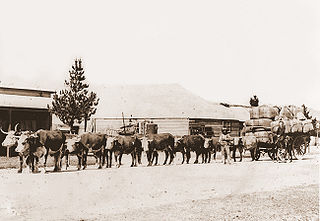
A working animal is an animal, usually domesticated, that is kept by humans and trained to perform tasks instead of being slaughtered to harvest animal products. Some are used for their physical strength or for transportation, while others are service animals trained to execute certain specialized tasks. They may also be used for milking or herding. Some, at the end of their working lives, may also be used for meat or leather.

A horse-drawn vehicle is a piece of equipment pulled by one or more horses. These vehicles typically have two or four wheels and were used to carry passengers or a load. They were once common worldwide, but they have mostly been replaced by automobiles and other forms of self-propelled transport but are still in use today.

A packhorse, pack horse, or sumpter refers to a horse, mule, donkey, or pony used to carry goods on its back, usually in sidebags or panniers. Typically packhorses are used to cross difficult terrain, where the absence of roads prevents the use of wheeled vehicles. Use of packhorses dates from the Neolithic period to the present day. Today, westernized nations primarily use packhorses for recreational pursuits, but they are still an important part of everyday transportation of goods throughout much of the developing world and have some military uses in rugged regions.

Llama hiking, also known as llama trekking or llama caravanning, is an activity where llamas accompany people on hiking and walking trips, including eco-tourism. Expeditions can last from as little as a few hours to several days. For longer trips the llamas often carry up to three days trekking supplies or cargo in purpose-built pack saddles so the people with them can carry as little as a day backpack. Treks are also offered, accompanied by the closely related alpaca.

Parc Safari is a zoo in Hemmingford, Quebec, Canada, and is one of the region's major tourist attractions; Parc Safari, an animal and amusement park was founded in 1972. It currently holds 500 animals of 50 different species. It is located close to the United States and draws many American visitors. It contains many African animals, including zebra, giraffe, dromedary camels, elands, rhinos, wildebeest, ostriches, lions, Ankole-Watusi cattle, and greater kudu. It also has many Asian animals, including Asiatic water buffalo, gaur, tigers, a Bactrian camel, yaks, and many different types of deer. Other animals include bison, llamas, wallabies, guanaco, elk, and wolves.

Pueblo Zoo is a 25-acre (10.1 ha) zoo located in Pueblo, Colorado in the United States. The zoo is open year-round and is home to over 420 animals of more than 140 species. The Pueblo Zoological Society manages the zoo, which is accredited by the Association of Zoos and Aquariums (AZA). The original core of the zoo was built in 1933–1940 by the Public Works Administration, Civilian Conservation Corps, and Works Progress Administration and is listed on the National Register of Historic Places as the Pueblo City Park Zoo.
Interspecific pregnancy is the pregnancy involving an embryo or fetus belonging to another species than the carrier. Strictly, it excludes the situation where the fetus is a hybrid of the carrier and another species, thereby excluding the possibility that the carrier is the biological mother of the offspring. Strictly, interspecific pregnancy is also distinguished from endoparasitism, where parasite offspring grow inside the organism of another species, not necessarily in the womb.
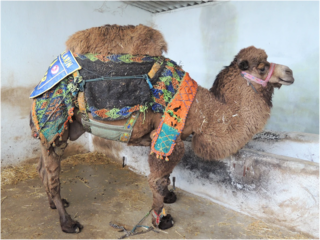
The hybrid camel is a domestic camelid hybrid between a Bactrian camel and dromedary. It is the offspring of a male Bactrian camel and a female dromedary.

Pack animals, such as the horse, llama, goat, dog, and donkey, are sometimes used to help carry the weight of a backpackers gear during an excursion. These animals need special considerations when accompanying backpackers on a trip. Some areas restrict the use of horses and other pack animals. For example, Great Basin National Park does not allow domestic animals at all in backcountry areas.

